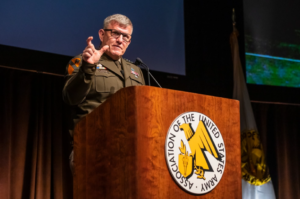HUNTSVILLE, Ala. — Army Futures Command (AFC) is officially standing up a new cross-functional team (CFT) focused on contested logistics, the command’s leader said Wednesday.
Gen. James Rainey, the AFC commander, told attendees at the Association of the United States Army’s Global Force Symposium in Huntsville, Alabama on Wednesday the new CFT will be based in the city and is set to reach initial operating capability in April.

“This CFT is going to be focused on tactical, so think division and below, aspects of all things that have to do with contested logistics. So we know we’ve got to get better at this problem,” Rainey said. “We’re putting it in Huntsville because Gen. [Charles] Hamilton, [head of Army Materiel Command] has the operational-level contested logistics problem and the strategic-level with the industrial base, so where else would you put the folks that are going to work on the division and below for that.”
Rainey is currently conducting a review of AFC’s CFTs, which brings together officials from different Army organizations to focus on specific modernization initiatives, telling reporters the assessment is likely to be completed in the next 90 days.
“Indisputably, one of the things we absolutely got right as an Army with AFC was the CFTs. [They’re about] identifying a clear problem, scope it and dogpile talent on it from all the stakeholders. My interest in CFTs is how do we make sure we follow through on what they’re doing and then capitalize on this good approach to generating transformational activities for us as we go from [2030] to [2040],” Rainey told reporters on Tuesday during a briefing at the Global Force conference. “It’s about capitalizing on something that works, not fixing something that’s not or a lack of emphasis or importance on the CFTs.”
Rainey said he doesn’t anticipate the review will lead to a “dramatic amount of shifting” with the current slate of CFTs, which range from teams focused on future vertical lift to next-generation combat vehicles.
As more modernization programs led by the CFTs transition into specific program offices or entities such as Training and Doctrine Command, Rainey noted those entities will have increased space in their portfolios for new efforts.
“As that capacity becomes available, what are the next things in that portfolio that we would add? That’s what the CFT evolution is about,” Rainey told reporters.